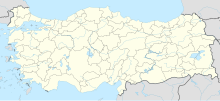Pompeiopolis (Paphlagonia)
Coordinates: 41 ° 31 ' N , 34 ° 13' E
Pompeiopolis ( Greek Πομπηιόπολις ), also Pompeioupolis ( Πομπηιούπολις ), was an ancient city in the Paphlagonia region of Asia Minor in the north of today's Turkey.
The remains of the ancient city lie on a hill near today's Taşköprü on the southern bank of the Gök Irmak (ancient: Amnias) on a road connection from western Asia Minor to Armenia. It was by the Roman general Gnaeus Pompeius Magnus during his war against Mithridates VI. of Pontos in 64 BC Founded. Apparently Pompey also settled Romans in the city named after him, as the names of residents and the use of the Roman calendar show. Pompeiopolis was initially part of the province of Bithynia et Pontus and was founded by Mark Antony in 39 BC. Subordinate to Galatian client princes. Pompeiopolis was re-established under Augustus and was the metropolis and seat of the parliament of Paphlagonia, which now belonged to the Roman province of Galatia . During the imperial period, several families from Pompeiopolis rose to the imperial aristocracy, such as those of Gaius Claudius Severus (consul suffect 112) , Gnaeus Claudius Severus Arabianus (consul 146) and Gnaeus Claudius Severus (consul 173) and possibly Tiberius Claudius Subatianus Aquila (prefect of Egypt 206-211) and Tiberius Claudius Subatianus Proculus (governor of Numidia 208-210). Perhaps, in the late 2nd century, the city was temporarily called Sebaste , as coins show.
In late antiquity, Pompeiopolis was the seat of a bishop, archbishop since the 6th century and metropolitan from the 11th century. The titular archbishopric of Pompeiopolis in Paphlagonia of the Roman Catholic Church emerged from the diocese .
In the Middle Byzantine period, the Amnias Valley was part of the Armeniacon theme in the 8th century and then belonged to the newly founded Paphlagonia theme since the early 9th century. The city is no longer mentioned in the written sources of the time; only again in 1390, when the later emperor Manuel II Palaiologos passed the area and described the city as abandoned and destroyed in a letter.
Since 2006, Pompeiopolis has been researched by an international team led by the Institute for Classical Archeology at the University of Munich. In the meantime, numerous buildings and areas have been identified and partially excavated, including the theater, parts of the agora, an extensive macellum and an imperial villa complex with elaborate floor mosaics.
literature
- Latife Summerer, Pompeiopolis-Tasköprü. 2000 Years from Metropolis to County Town (Istanbul 2017), ISBN 978-605-9680-67-7
- Christian Marek : Pompeiopolis. In: The New Pauly (DNP). Volume 10, Metzler, Stuttgart 2001, ISBN 3-476-01480-0 .
- Latife Summerer (Ed.): Pompeiopolis I: An interim balance sheet from the metropolis of Paphlagonia after five campaigns (2006-2010) Beier & Beran, Langenweißbach 2011, ISBN 978-3-941171-63-3 .
- Latife Summerer, Alexander von Kienlin, Georg Herdt, Early Research in Paphlagonia - New Excavations in Pompeiopolis, Anatolian Metal IV, Beiheft 25, Bochum 2013, 257-266.
- Latife Summerer, Alexander von Kienlin, Pompeiopolis. Metropolis of Paphlagonia, in: Hadrien Bru, Guy Labarre (ed.), L'Anatolie des peuples, des cités et des cultures. (IIe millénaire av. J.-C. - Ve siècle ap. J.-C.). Colloque international de Besançon - November 26-27, 2010 (2 vols.). Besançon: Presses universitaires de Franche-Comté, 2014. 115-126. ISBN 9782848674735 .
- Julie Dalaison, "L'atelier monétaire de Pompeiopolis en Paphlagonie", in Delrieux (F.) et Kayser (Fr.), éd., Hommages offerts à François Bertrandy, Tome 1: Des déserts d'Afrique au pays des Allobroges, Laboratoire Langages, Littératures, Sociétés, Collection Sociétés, Religions, Politiques, n ° 16, Chambéry, 2010, p. 45-81.
Web links
Remarks
- ↑ Olli Salomies: The origin of the Numidian legate T. Claudius Subatianus Proculus . In: Journal of Papyrology and Epigraphy . tape 119 , 1997, pp. 245-248 ( PDF online ).
